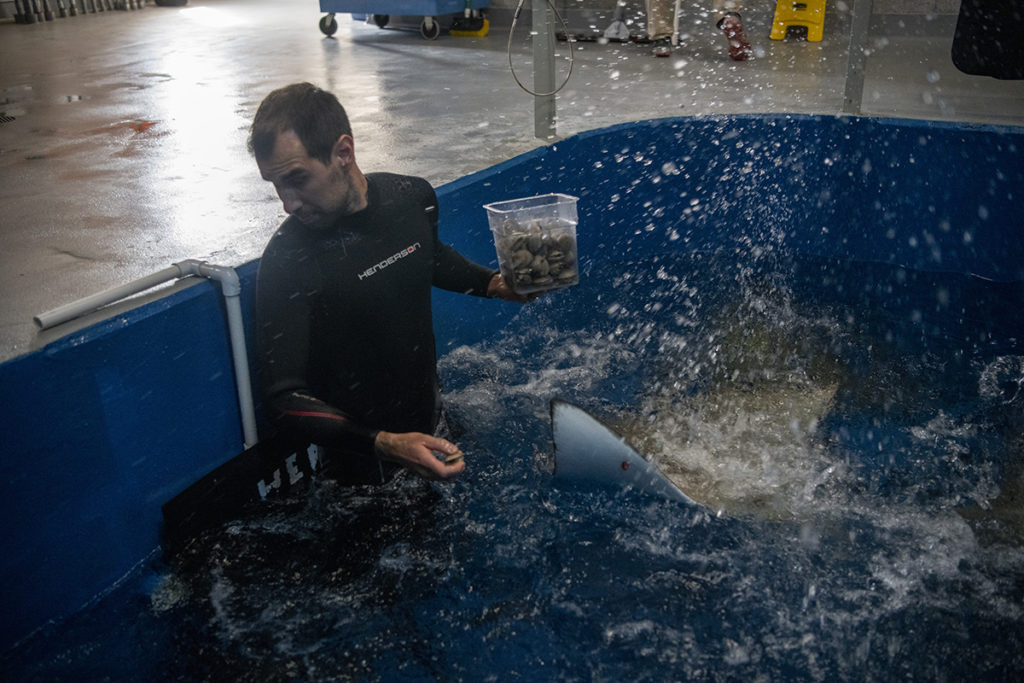It’s hard to describe the awe when you stand at the Baja Bay window in Point Defiance Zoo’s Pacific Seas Aquarium and watch spotted eagle rays swoop through blue water overhead. But Tyler, one of the zoo’s aquarists, gets an even more immersive experience: waist-deep in their 80-degree water, feeling velvety noses as they munch the clams he’s feeding them by hand.
7am
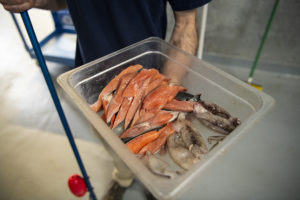
Tyler’s day begins early with a walk around the Pacific Seas Aquarium to get a good look at all the animals.
“I want to check on everyone, make sure everything’s okay,” he says.
Then he makes breakfast: preparing seafood diets for hammerhead sharks, eagle rays, green sea turtles and more. It’s a lot of chopping – the sharks and rays each consume four to five pounds of food daily.
8:30am
Feeding time in the Baja Bay habitat takes three aquarists: one for rays, the other two for sharks.
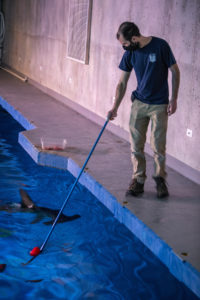
Aquarists use targets in different shapes and colors on long poles, rewarding animals with their meal when they come to their particular target. It’s a way of making sure everyone gets exactly the right diet, vitamins and necessary medications.
9:30am
Dive time! All the aquarists are trained scuba divers, and Tyler’s no exception.
“I dive at least twice a week in the Pacific Seas Aquarium,” he explains, “to clean the windows, pick up debris and monitor animals.”
In Baja Bay he also searches the habitat floor for eagle ray teeth. Like sharks, rays shed teeth regularly as new ones grow in, and finding them gives Tyler and his team a better idea of the ray’s health and growth.
While wetsuit diving in Baja is cozy at the 80 degrees these tropical animals need, diving in the Coastal Kelp Forest habitat is another story. Mimicking the waters off Northern California, the temperature hovers between 62-65 degrees – a dry suit is too hot, but a wetsuit gets a little chilly sometimes, says Tyler.
10:30am
Twice a week, though, it’s time for something pretty special: Hand-feeding whole clams to eagle rays.
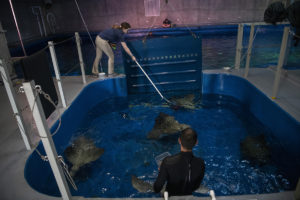
“Whole clams are really good for these rays,” explains Tyler. “It would be part of their diet in the wild, and the crunching helps them shed teeth regularly. Plus, it’s a big treat for them.”
Tyler’s standing in waist-deep water in the isolation pool, a small shallow area at the top of Baja Bay that can be closed off from the main pool by a gate. Michaela, a fellow aquarist, is poised with the gate’s remote control, while another aquarist sits cross-legged on the other side of Baja distracting turtles with food.
From a bucket on the edge, Tyler grabs a clam and waves it through the water. Two rays rush in, followed quickly by three more. Both aquarists laugh.
“It’s a party!” says Tyler, as Michaela ushers a couple back out with a pole. “Three at a time is best, so it’s not too chaotic.”
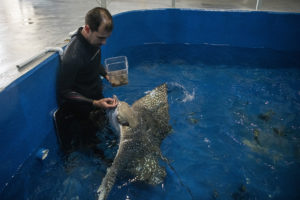
Finally it’s just Tyler with three rays, each of whom he recognizes instantly from the constellation of white dots on their foreheads. Pulling clam after clam out of the bucket, he offers them to the rays in an open hand, a bit like feeding a horse or goat.
Wings splashing, the rays circle around Tyler, nuzzling up to take the clam with a rippling snuffle of their noses. They’re clearly excited, and completely trusting in the wetsuited man gently offering them food.
“They smell and see the clams, but they also sense them with electro-receptors, just like sharks,” explains Tyler, smiling down at the rays. “And they’re not aggressive at all.”
When the rays were very small Tyler cared for them in smaller pools behind the scenes in the Aquatic Animal Care Center.
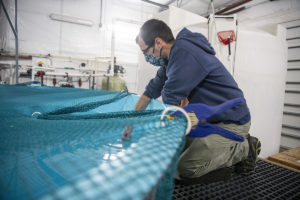
“If you put your ear up to the side, you could hear them crunching the clams,” he remembers. “It’s very cool.”
It’s time for the other two rays now, and Tyler and Michaela work as a team to swap them over. A female with a triangle of dots on her head almost caresses Tyler with one wing. Four or five Moorish idol fish swim in opportunistically, scavenging up the scraps, and the three green sea turtles cruise outside the gate, interested.
“The other huge advantage to hand-feeding is that the rays get comfortable coming into the isolation pool,” explains Tyler, “which is essential if we need to do an exam or medical treatment. Plus, it contains the mess.”
Sure enough, when Tyler calls out “All done!” and Michaela closes the gate after the last ray, the floor of the small pool is littered with clamshells. The aquarists get to work cleaning up with broom and net, avoiding a couple of orange soldier fish who are ‘helping’.
“It’s very much a team job,” he says.
1:30pm
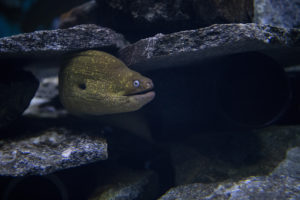
After lunch there’s sometimes another Baja feed, then Tyler cleans up buckets, dishes and the prep kitchen. This is the time he gets to work on special projects like creating enrichment items for animals, or solutions to challenges – like feeding the new moray eels in the Coastal Kelp Forest.
“It’s challenging feeding eels,” says Tyler, who gained a marine biology degree and worked or interned at aquariums around the country and Canada before landing the Tacoma job ten years ago. “They like to hide right down near the bottom, and we don’t want the sheephead fish to take their food first.”
So the aquarist has built an ingenious tool made of several sections of PVC pipe connected to an empty two-liter plastic bottle. Food goes right down the bottom into the bottle, where the eels can access it easily when the aquarist has positioned it right outside their rock dens, ten feet below. Perfect.
3pm
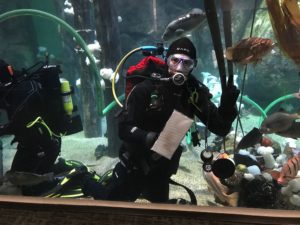
Time for another round to check on all aquarium habitats and animals, and then Tyler’s day ends at 4pm. He’s been in and out of water, mucky with seafood and occasionally chilly, but he loves it.
“I like interacting with animals up close,” he says. “That’s what got me into this job in the first place. I also like the creativity, solving problems of life support or husbandry, brainstorming with my team.”
And his least favorite part?
“The computer work,” he says wryly. “I’d rather be around water.”
